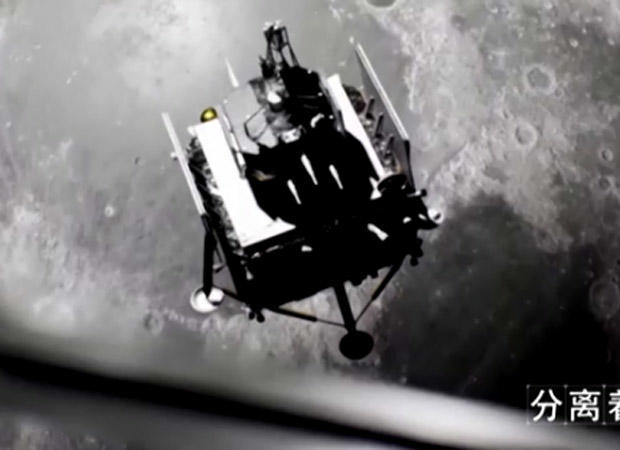China says spacecraft successfully lands on moon for historic sample collection
A Chinese robot probe landed on the moon Tuesday, touching down on a broad plain known as the Ocean of Storms in a bold attempt to scoop up rocks and soil and return them to Earth for laboratory analysis, the first such lunar sample collection in nearly 45 years.
"At 23:11 on December 1 (10:11 a.m. EST), the Chang'e 5 probe successfully landed on the pre-selected landing area near the front of the moon at 51.8 degrees west longitude and 43.1 degrees north latitude," the Chinese space authorities reported in translated remarks.
After touchdown, the agency said, the lander deployed its solar wings and a directional antenna and began preparing for sample collection, a procedure expected to take about two days.
"Congratulations to China on the successful landing of Chang'e 5," tweeted Thomas Zurbuchen, NASA's science director. "This is no easy task. When the samples collected on the moon are returned to Earth, we hope everyone will benefit from being able to study this precious cargo."
If the sample collection and return to Earth are successful, China will become only the third nation, after the United States and the former Soviet Union, to bring moon rocks back to Earth, and the first since Russia's robotic Luna-24 mission in 1976.
Named after the mythical Chinese goddess of the moon, the 8,335-pound Chang'e 5 spacecraft features four major components: a lunar orbiter and sample return craft; the lander carrying science instruments and sample collection gear; and a small ascent vehicle mounted atop the lander to carry the collected surface samples back up to orbit for return to Earth.
Launched November 23 atop a powerful Long March rocket, the Chang'e 5 spacecraft braked into orbit around the moon on Saturday and released the lander the next day. On Tuesday, the lander fired its main engine at 9:57 a.m. EST to drop out of orbit for the long-awaited descent to the surface.
During the final stages of the descent, the probe's flight computer carried out automatic obstacle avoidance procedures before dropping vertically to a gentle touchdown at 10:11 a.m. and beaming back a camera image of the ground below the spacecraft.
The flight plan calls for a short two-day stay on the surface. The lander is expected to photograph its surroundings in detail with high-definition cameras and use a spectrometer and ground-penetrating radar to assess the area near the spacecraft.
A robot arm equipped with a percussive drill and scoop will excavate and pick up loose rock and soil. The arm then will transfer the collected samples up to the ascent vehicle, which is expected to blast off Thursday, using the lower half of the lander as a launch pad.
After a climb back to lunar orbit, the spacecraft will rendezvous and dock with the Chang'e 5 orbiter Saturday and transfer the samples to the return craft for the trip back to Earth. Landing in Inner Mongolia is expected around December 16.
China is executing an incremental approach to its moon program, launching a series of increasingly complex robotic spacecraft to develop and test the propulsion, guidance, navigation and landing systems needed for long-term exploration.
The Chang'e 1 and 2 missions successfully reached lunar orbit in 2007 and 2010 respectively, followed by the Chang'e 3 lunar lander in 2013 and Chang'e 4, which landed on the far side of the moon in 2019. Chang'e 5 is the first of two planned sample return missions and China's most ambitious moon mission to date.






